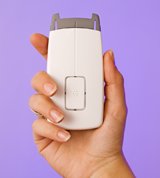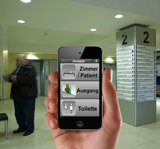Arab Health 2012
January 23 to 26, 2012 in Dubai, United Arab Emirates, German Pavilion, Booth ZE70
ECG System with integrated Evaluation of ECG and Movement Signals
At present, the evaluation of long-term ECGs is performed by the attending physician, who enters the ECG data into a PC where it undergoes a preliminary analysis in a software programme following a consultation in the physician's office. The physician looks at the flagged critical areas and makes a diagnosis. For years Fraunhofer IPMS has been researching a suitable algorithm, which will make an analysis directly within ECG recorder possible. The goal is to provide a comprehensive evaluation of the current cardiac function. For this purpose, diverse methods are employed, such as rhythm analysis, QRS classification, analysis of the atrium activity, as well as QT measurement. This software is part of the portable »SmartVital« recorder presented at Arab Health 2012. When the analysis software detects a change in the ECG, the recorder immediately sends an excerpt of the ECG through a gateway to an Medical Evaluation Center or a physician, who can then make a decision regarding follow-up. This way, long-term evaluation can be performed without the patient having to go to the doctor repeatedly. Parallel to the ECG recording, the patient's movements and physical activity are also recorded and analyzed: The instrument automatically recognizes whether the patient is standing, lying down, walking, running, or climbing stairs. This means that an ECG recording can be performed under real everyday conditions, without the patient having to keep a diary of his daily activities. Due to the link between the physical activity data and the ECG data, an improvement in the analysis results is achieved. In particular, changes occurring in the ECG can be correlated to the corresponding physical stress situations, and disturbances caused by movement artefacts can be effectively reduced. If the patient is climbing stairs, for example, and the heart rate increases, then pathological tachycardia will not be mistakenly identified, as an increase is normal under such stress conditions.
Indoor Navigation in Hospitals
With their countless buildings, halls and rooms, large medical facilities such as hospitals and rehabilitation centres can often turn into what seems like a labyrinth. On a first visit, it is easy for people to lose their way and only find it again after a long search and repeatedly having to ask for directions. The system developed by Fraunhofer IPMS navigates the user to his destination reliably – both indoors and on the hospital grounds between buildings. After the destination has been selected, the visitor's position and the calculated route are displayed on a smartphone. The route is constantly updated in the same manner one would expect from any other navigation system. If the user deviates from the original route, the system suggests a new and optimized route. An acoustic output completes the directions. By entering corresponding map data, the system can be used for any number of facilities.
About Fraunhofer IPMS
The Fraunhofer Institute for Photonic Microsystems IPMS and its 220 employees turn over an annual research volume of nearly 26 million euros. Fraunhofer IPMS generates more than two thirds of this production capacity out of commissions from industry and publicly financed projects in applied research. The focus of our development and production services lies in the practical industrial application of unique technological know-how in the fields of (optical) micro-electromechanical systems [MEMS, MOEMS]. Fraunhofer IMPS uses scientific know-how, application experience and customer contacts as well as modern equipment and clean room infrastructure. Fraunhofer IPMS covers a broad spectrum of industrial applications. Our services range from initial conception to product development, right down to serial pilot production – from a single component to a complete system solution.
 Fraunhofer Institute for Photonic Microsystems
Fraunhofer Institute for Photonic Microsystems
